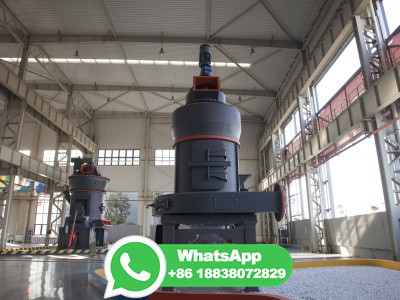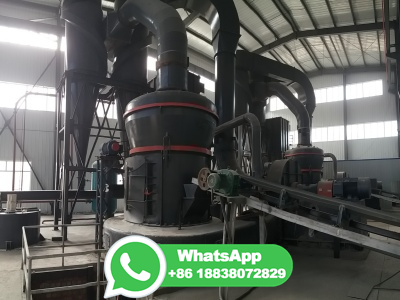
The Ore Extraction and Refining Process Before iron ore can be used in a blast furnace, it must be extracted from the ground and partially refined to remove most of the impurities. ... On the surface, the future of iron production—especially in the United States—appears troubled. Reserves of highquality ore have become considerably ...
WhatsApp: +86 18838072829
The Bessemer Process for Steel production and; The Open Hearth Process of Steelmaking; Steel manufacturing Principle of the Bessemer Process. The main raw materials for Steel production in a blast furnace are Iron ore, limestone, coke, and some scrap steel. These materials are charged into the blast furnace from the top and converted into ...
WhatsApp: +86 18838072829
Australia's total production of iron ore for 2018 was 899 Mt (Table 3), with Western Australia producing 891 Mt or 99% of overall production. ... 4 Agglomeration is the process in which magnetite grains are aggregated into pellets using a chemical binding reagent. Pellets are produced in a pelletising plant. 5 Fortescue Metals Group. ASX ...
WhatsApp: +86 18838072829
Blast furnaces produce pig iron from iron ore by the reducing action of carbon (supplied as coke) at a high temperature in the presence of a fluxing agent such as blast furnaces consist of several zones: a crucibleshaped hearth at the bottom of the furnace; an intermediate zone called a bosh between the hearth and the stack; a vertical shaft (the stack) that extends from ...
WhatsApp: +86 18838072829
Iron Mining Process. From blasting to crushing to separation more than 85% of the iron mined in the United States is mined in northeastern Minnesota to make our nation's steel. Blasting Taconite is a very hard rock. Using explosives, the taconite is blasted into small pieces. ... The iron ore is separated from the taconite using magnetism ...
WhatsApp: +86 18838072829
The six main steps of iron ore processing When iron ore is extracted from a mine, it must undergo several processing stages. Six steps to process iron ore 1. Screening We recommend that you begin by screening the iron ore to separate fine particles below the crusher's CSS before the crushing stage.
WhatsApp: +86 18838072829
Global iron ore production was billion metric tons (Gt) of usable ore, containing an estimated Gt of iron, a slight increase from Gt of usable ore in 2017. Global ... The use of this process increased slightly to % of total steel production in 2018 from % in 2017 (American iron and Steel institute, 2019, p. 7071, 73).
WhatsApp: +86 18838072829
IRON ORE. Riding on the back of the phenomenal boom in steelmaking within China, world iron ore production surpassed 2 billion tons per year (B t/y) earlier this decade, which is up by more than 2to1 since (see TABLE I).Since passing the 2B t/y mark, growth has slowed and output has remained relatively level, as demand is now being satisfied.
WhatsApp: +86 18838072829
Iron Production Iron is produced in blast furnaces by the reduction of iron bearing materials with a hot gas. The large, refractory lined furnace is charged through its top with iron as ore, pellets, and/or sinter; flux as limestone, dolomite, and sinter; and coke for fuel. Iron oxides, coke and fluxes react with the
WhatsApp: +86 18838072829
The ironmaking process in the blast furnace is a heat and mass transfer process, and the furnace can be divided into different zones according to physical and chemical state of the feed and temperature. Figure illustrates various zones of the blast furnace and feed distribution and materials flow [ 13 ].
WhatsApp: +86 18838072829
The blast furnace and direct reduction processes have been the major iron production routes for various iron ores ( goethite, hematite, magnetite, maghemite, siderite, etc.) in the past few decades, but the challenges of maintaining the iron and steelmaking processes are enormous. The challenges, such as cumbersome production routes, scarcity of metallurgical coke, high energy demands ...
WhatsApp: +86 18838072829
The raw materials mix or "charge" enters the furnace from the top and hot air is blown or blasted from the bottom causing the coke to burn and the oxygen to combine with carbon in the coke to form carbon monoxide. Now, this carbon monoxide that is unstable, reacts with the ore to form carbon dioxide and iron. The Separation Of Iron
WhatsApp: +86 18838072829
Main Uses of Iron Ore. In addition to steel, iron ore plays an important role in the creation of several products. Uses. Description. Steel. About 98% of iron ore production goes to making steel. Tools, automobile parts, buildings, bridges and ships are a few of the many items made from steel. Iron Chloride.
WhatsApp: +86 18838072829
Current practice of washing iron ore before it is processed for extractive metallurgical operation results in three products, coarse ore lumps with sizes in the range 1080 mm, which are directly charged to a blast furnace, the classifier fines of size 150 μm to 10 mm, which, with or without beneficiation are fed to sinter plants, and the tailin...
WhatsApp: +86 18838072829
The production of iron from its ore involves a redox reaction carried out in a blast furnace. The furnace is filled at the top with the iron ore oxide most commonly hematite ((Fe_2O_3)) but can also magnetite ((Fe_3O_4)), carbon called coke and limestone ((CaCO_3)). ... As the process continue the molten iron flow down through the furnace ...
WhatsApp: +86 18838072829
In 2004, SNIM mined of ore and shipped 11Mt of product, % more than in 2003. SNIM reported exports at in 2005. Approximately 60% of deliveries comprise directshipping grades, with 40% made up of concentrates, and more than 90% of the tonnage goes to European markets. SNIM produced of iron ore in 2020, which is an ...
WhatsApp: +86 18838072829
In the integrated steelmaking route, iron ore containing ferrous oxides is converted to metallic iron inside the blast furnace via a chemical process called 'reduction'. ... alumina and phosphorus strongly impacting the efficiency and competitiveness of the EAF process, DRI production must use the very highest quality iron ore, with an ...
WhatsApp: +86 18838072829
The iron ore industries of India are expected to bring new technologies to cater to the need of the tremendous increase in demand for quality ores for steel making. With the highgrade ores depleting very fast, the focus is on the beneficiation of lowgrade resources. However, most of these ores do not respond well to the conventional beneficiation techniques used to achieve a suitable ...
WhatsApp: +86 18838072829
It's a long process which begins with Concentration through calcination roasting. Concentration removes the water and other volatile impurities such as sulphur and carbonates. This concentrated ore is mixed with limestone (CaCO 3) and Coke and fed into the blast furnace from the top. It is in the blast furnace that extraction of iron occurs.
WhatsApp: +86 18838072829
Direct Reduced Iron (DRI): This iron production process directly reduces iron ore in solidstate with the reaction temperature below the melting point of iron. Reducing gases are produced from natural gas (gasbased DRI) or coal (coalbased DRI) called syngas, a mixture of H2 and CO. Although DRI production is more energy efficient than pig ...
WhatsApp: +86 18838072829
Today there are two major commercial processes for making steel, namely basic oxygen steelmaking, which has liquid pigiron from the blast furnace and scrap steel as the main feed materials, and electric arc furnace (EAF) steelmaking, which uses scrap steel or direct reduced iron (DRI) as the main feed materials.
WhatsApp: +86 18838072829
Iron is mainly extracted from hematite (Fe 2 O 3) and magnetite ores. Natural or direct shipping iron ores contain between 5070% iron and can be fed directly into the blast furnace. Fe 3 O 4 decomposes when heated to ferrous oxide (FeO) and ferric oxide (Fe 2 O 3) via Fe 3 O 4 → FeO + Fe 2 O 3. A specialized type of coal, called hard coal ...
WhatsApp: +86 18838072829
In iron ore flotation process, air is bubbled through a suspension of fine iron ore in water to which a small quantity of flotation reagent is added. ... The sintering process is a pretreatment step in the production of iron, where fine particles of iron ores and in some plants, also secondary iron oxide wastes (collected dusts, mill scale ...
WhatsApp: +86 18838072829
"The green briquettes being produced with our highgrade iron ore will also allow high furnace performance with lower slag volumes, and this is totally aligned with our customers' decarbonization goals," Spinelli added. Vale is also confident in the production process because of internal efficiencies and product flexibility.
WhatsApp: +86 18838072829